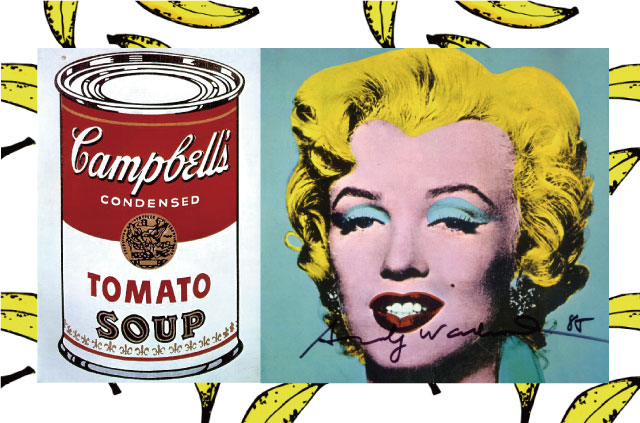
Have you ever wondered who painted the famous paintings of Campbell's soup cans, or who depicted Marilyn Monroe as a multicolored celebrity on canvas? The artist behind these renowned paintings and of many others is Andy Warhol, the Pope of Pop. Fascinated by the relationship between artistic expression and advertising, Warhol took well-known American objects such as Coca-Cola bottles, Campbell's soup cans, dollar bills, as well as celebrities, and manipulated them to create his art. This pop art—an experimental art form based upon themes and techniques taken from popular mass culture—has been imitated by other artists ever since. While it may not seem unusual now, back in the 1960's this kind of art was groundbreaking, altering people's perceptions of what could be considered art. Born in 1920s Pittsburg, Pennsylvania, Warhol was often sick and confined to his bed as a child. Stuck at home, he filled his time by drawing, listening to the radio, and collecting pictures of movie stars. Warhol described this time in his life as being vital to the development of his personality, style, and interest in popular culture. In addition to being an artist, Warhol was also a keen businessman and, unlike many other artists, was not shy about benefiting financially from his creations. Warhol was obsessed with mass production, claiming that he wanted to become a machine, able to reproduce the same image over and over again. As a result of this fascination, he switched from painting to screen printing, a technique that allowed him to reproduce copy upon copy of identical images. After a time, he even stopped producing these works himself, employing assistants to create the prints for him. For Warhol, the business of churning out these prints was as much a form of art as putting paint onto canvas. "Making money is art, and working is art, and good business is the best art," he wrote in one of his books. Warhol's work foresaw much of what preoccupies us in the twenty-first century—fame, the media, and an insatiable appetite for mass-produced products. Consequently, though he was criticized at the time for giving in to consumerism, Warhol's art has never gone out of fashion.
你是否曾納悶過,是誰繪製康寶濃湯罐頭上的知名圖像?又是誰在畫布上呈現色彩鮮豔的瑪麗蓮• 夢露名人肖像?這些響噹噹畫作背後的推手,就是「普普藝術教父」──安迪• 沃荷。 沃荷對於藝術融合廣告的表達方式著迷不已,他將可口可樂罐、康寶濃湯罐、美金鈔票等家喻戶曉的美國物品以及名人肖像,幻化為充滿自我風格的藝術作品。以大眾流行文化的主題與傳播技巧為基礎,所產生的實驗性質「普普藝術」風格,在往後廣受其他畫家仿效。雖然現在已是司空見慣的表達手法,但在1960 年代時可說是十分前衛,改變了人們對藝術的看法。 沃荷生於1920 年代的賓州匹茲堡,小時候常臥病在床。在家動彈不得的他,以畫畫、聽收音機,還有收集電影明星照片的方式充實自己。沃荷表示,童年階段是培養他人格特質、作風,以及對流行文化產生興趣的關鍵。 除了畫家身分以外,沃荷還是一名熱衷商業的生意人。他與其他畫家不同,完全不會因為銷售創作獲利而感到不好意思。沃荷執著於量產策略,他想成為一部不斷重製相同圖像的機器。也因為這股熱情,讓他從繪畫轉戰網版印刷(譯註:又稱絹印),此技術能讓他大量重製相同的作品。 經過一段時間後,他甚至不再事必躬親,而是雇用助理負責絹印量產的工作。對沃荷而言,印刷事業也等於在畫布作畫的一種藝術形式。他在自己的著作中表示:「賺錢是藝術,工作也是藝術,而會賺錢的生意是表達藝術的最高境界。」 沃荷的作品彷彿有先見之明,呈現21 世紀所風靡的現象,例如名氣、媒體,以及大眾對量產商品貪得無饜的胃口。因此,縱使沃荷當時遭到向消費主義妥協的批評,他的普普藝術仍從未退流行。 |
沒有留言:
張貼留言